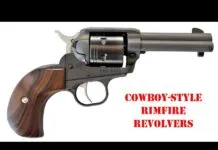In the early 20th century, when many classic double, pump, and semi-auto shotguns were built and sold, there was no consensus among gun makers about the “correct” length of shotgun ammunition. For instance, 10-gauge shotguns were chambered for either 2 7/8-inch or 3 1/2-inch ammunition, and 12- and 20-gauge shotguns were commonly chambered for ammunition ranging from 2 inches to 3 inches in length. Shotguns chambered for 16 gauge used 2 9/16-inch or 2 3/4-inch shotshells. The .410 was common in 2-, 2 1/2-, and 3-inch shotshell lengths, and the European gun makers added a metric dimension to all this confusion, making the chamber-length possibilities seemingly infinite. It’s not hard to see why gunsmiths can benefit by being able to change shotgun chamber and chamber forcing cone lengths to allow older, still serviceable shotguns to fire modern ammunition.
In addition to having chambers of various lengths (often too short to accommodate a modern shotshell), these early shotgun chambers had very short forcing cones that were designed to work with shotshells now obsolete. These older shotgun shells were made without a protective shot cup. Because of this shotshell design, a relatively quick seal of shot column to bore was necessary. The short forcing cone of our older shotguns was important to ensure that very little gas passed by the shot column as the shot went from shell to bore. This gas would certainly have been disruptive to the shot column, and any disruption would have a detrimental effect on the shotgun’s pattern.
Modern shotgun ammunition has its shot column completely protected, usually in a one-piece wad and shotcup. Since the shot column is now protected from the expanding gas propelling the shot charge, the abrupt forcing cone is no longer necessary; in fact, even better patterns can now be had by lengthening the chamber forcing cone so the shot column receives less damage as it is forced from shell to bore.
The longer forcing cone has the additional benefit of acting as less of an obstruction to the shot column. This allows chamber pressures to build a bit more gradually, spreading the recoil sensation over a longer period of time, resulting in lower felt recoil.
The long chamber forcing cone is a feature that the public has been thoroughly sold on in recent years. Shotgun manufacturers are now offering the long forcing cone in many target-grade guns, and gun writers in every magazine covering shotgun sports have at one time or another endorsed the long forcing cone.
Here is how the modifications are done.
Hand Lengthening
Lengthening a chamber and lengthening a forcing cone are the same operation when both are done with a long forcing cone chamber reamer. If it‘s a short chamber that you are lengthening, you will first have to determine its length by carefully measuring it with a chamber gauge. This is a very simple procedure, since you are only concerned that the gauge goes in all the way or does not. It is helpful to first clean the chamber to ensure that dirt and rust do not impede the gauge.
To lengthen a chamber and/or a chamber forcing cone by hand, you will first need to secure the barrel in a bench vise. I like to use a couple of pieces of 2- by 4-inch lumber and an old shot bag to pad the vise. Make sure the barrel is held very tightly in your vise because there is a great amount of torque exerted during this operation.
With a well oiled and sharp long forcing cone reamer, begin cutting your new chamber by turning the tool clockwise. You will be amazed at how quickly a sharpened tool begins to remove material. After cutting no more than 3/8 inch, remove your reamer, brush off the chips, push a patch through the bore, re-oil, and resume cutting. Always rotate the reamer in a clockwise direction—even when removing it from the bore.
Continue these steps until your chamber gauge shows that your chamber is the desired length. Now take note of how much of your forcing-cone reamer is outside of the shell recess while it is cutting. Since a shotgun’s headspace is not determined by the length of the chamber or the forcing cone, this dimension can be used to tell you when your chamber has reached its desired length.
At this point I like to make one more cut, using very little pressure on the tool. This will give you a very fine finish on the new forcing cone and very little polishing will be needed to finish it off.
Lathe Lengthening
If you do a lot of shotgun barrel work, you will find that lengthening forcing cones and chambers is made easier on a lathe.
To set up your lathe to handle this task, you will need a milling vise mounted on your tool post. A very good one is made by Palmgren and is available in the Brownells catalog. Attach the vise to your tool post with the vise jaws parallel to the lathe ways, clamping it down with an inverted tool holder. You will also need some sort of floating adapter to attach your reamer to the lathe spindle. This will allow the tool to follow the bore as it cuts its new forcing cone. The adapter can be held in a collet or in a three-jaw chuck. To align a barrel with your lathe spindle, insert a tapered chamber mandrel into the clean chamber of your shotgun barrel (shotgun chamber mandrels in 12 and 20 gauge are also available from Brownells). With the barrel and mandrel securely held in the lathe headstock, raise the lower jaw of your milling vise to meet the barrel. Pad the vise jaws with a section of canvas shot bag.
If your vise has a V-groove milled in its lower jaw, align this groove with the center of the barrel. It is helpful to turn the shotgun barrel counterclockwise (as you face the headstock) until the shotgun‘s vent rib contacts the lower vise jaw. There will be considerable torque exerted on the shotgun barrel during machining, and this will keep the barrel from rotating in your vise. Close the vise around your barrel and mandrel.
Next, loosen and then retighten the bolt that controls the tilt of your milling vise. This will ensure there is no tension. Loosen your three-jaw chuck or collet and move your lathe apron to the right, observing the mandrel’s alignment with the collet or chuck. Remove the mandrel and attach your tool holder to the lathe spindle. With your chamber well oiled, insert your long forcing cone reamer and attach the reamer to the floating adapter. Set your spindle speed to 55 to 65 rpm and begin milling the barrel by moving it toward the tool using the apron hand wheel.
You will have to stop, remove chips and re-oil your tool a few times during the milling process. When you reach the desired chamber length, make a final cut at very low feed rate. I like to use the auto feed set at its lowest position (on my Southbend lathe that is .0015 inch per revolution). This will give you a chamber and forcing cone surface that will need very little polishing to complete.
Polishing
Polishing a finished forcing cone can be done in a number of ways. A brake cylinder hone can be used on an electric drill. I find that the “ball type” brake cylinder hones work best.
Try to find one that will fit snugly in your forcing cone. Start polishing with a dry hone, and when you have honed the forcing cone to a reasonably smooth finish, oil the hone and run it for another minute. Be sure to oil the new chamber and forcing cone before returning the barrel to your customer. You will find that freshly machined and polished forcing cones rust very quickly if you skip this step. Once the barrel has been used a bit, the surface of the forcing cone will be burnished and less likely to rust.
I prefer to polish forcing cones on the lathe, using a piece of hardwood dowel that has been slit about 3 inches along its axis with a hacksaw. I insert a length of medium-grit emery cloth in the slit and wrap the remaining emery cloth clockwise around the dowel. Spin this very rapidly in the lathe using the three-jaw chuck to attach it. A little experimentation will show you the correct length of emery cloth needed to polish the chamber and forcing cone. It should fit very tightly in the forcing cone, and it should be used dry.
A very hard application of this device will quickly polish the cone and both burn and load up the emery cloth. Continued polishing will give your forcing cone a polished and burnished surface. This will give you a very smooth forcing cone finish that will stand up to the scrutiny of even the most demanding shotgun shooter.
Safety Concerns
There are a number of safety considerations to remember before you lengthen shotgun chambers.
You will run into many short-chambered double-barreled shotguns whose owners would like them rechambered for 3-inch ammunition. Although the barrels themselves would probably hold up to the pressure of 3-inch shotshells, there is no reason to think that the rest of the action could take the extra abuse. Remember, these shotguns were made long before advances in our ammunition propellants that give us the shotshell performance that we enjoy today. Never lengthen the chambers of a Damascus or laminated-steel shotgun barrel.
When it comes to modern shotguns, almost all of the 2 3/4-inch-chamber barrels that you find can be safely lengthened to 3 inches, but you must also consider the shotgun’s ejector position and gas system (if the shotgun happens to be a gas-operated automatic). A Remington 870, for example, can easily and safely be lengthened to 3 inches. Its ejector is located in the receiver of the shotgun and it will easily eject a fired 3-inch shotshell.
On the other hand, if you put a fired 3-inch shotshell in the chamber of an Ithaca model 37, it will not eject. Its ejector and ejection port would need extensive modification to accommodate a fired 3-inch shotshell. Gas-operated shotguns like the Remington 1100 or Winchester 1400 would seem to have plenty of barrel material to handle the increased pressure of a 3-inch shotshell, but the increase in gas pressure and volume will certainly cause excessive wear in the rest of the shotgun action, since its gas ports have been calibrated to operate with the pressure of 2 3/4-inch shotshells.
Originally published as chapter 23 ofAmerican Gunsmith’s Book of the Shotgun.



























I don’t understand the statement about the added pressure of 3″ shells compared to 2 3/4″ shells. The SAAMI maximum pressure for both is 11,500 psi. 3″ shells are not higher pressure than 2 3/4″ shells.